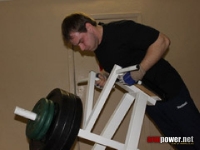And each of these stages performs its task. In this article I will try to draw your attention to the stage of preliminary preparations and early specialization, clearly emphasizing the physical preparation, based on personal experiences.
First, take a look in history. As you probably know, armwrestling has newly existed in Russia. Actually, 20 years have not yet even passed since the official emergence of this sport. First fans of the sport met with a ton of questions about the methodology of training, the organization of a training system, not to mention the technique, spars and preparation for competitions.
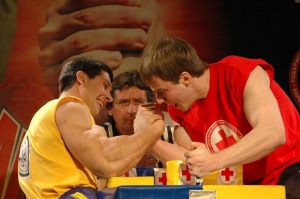 Most of the champions of the early 90's came to armwrestling from other sports such as weightlifting, power-lifting, or wrestling. As examples, we can provide sports biographies of prominent people such as 14-times World Champion Jan Germanus (Slovakia) - world record-holder in bench press, before armwrestling he successfully practiced power-lifting; legendary armwrestler Andrey Yunkov - simultaneous champion in power-lifting and wrestling; Master of International Class Andrey Antonov - one of the few people in Russia who managed to win with John Brzenk from the U.S.A., he is also a candidate for the Champion in athletics and power-lifting, the first USSR Champion, World Champion in heavyweight Aleksandr Kuznecov - until the first success in armwrestling he was a master in wrestling in a classic style; prominent Ossetian armwrestler, now a talented coach Aslanbek Enaldiev – was the first in his republic in weightlifting, he was awarded with the title of "Distinguished Master of Sport", "Distinguished Master of Sport" Andrey Kruglov - champion in sambo and judo. The powerful "base" helped these and many other athletes, in a relatively short period of time to achieve the highest skills in new sports, as opposed to those who at that time started from scratch.
Most of the champions of the early 90's came to armwrestling from other sports such as weightlifting, power-lifting, or wrestling. As examples, we can provide sports biographies of prominent people such as 14-times World Champion Jan Germanus (Slovakia) - world record-holder in bench press, before armwrestling he successfully practiced power-lifting; legendary armwrestler Andrey Yunkov - simultaneous champion in power-lifting and wrestling; Master of International Class Andrey Antonov - one of the few people in Russia who managed to win with John Brzenk from the U.S.A., he is also a candidate for the Champion in athletics and power-lifting, the first USSR Champion, World Champion in heavyweight Aleksandr Kuznecov - until the first success in armwrestling he was a master in wrestling in a classic style; prominent Ossetian armwrestler, now a talented coach Aslanbek Enaldiev – was the first in his republic in weightlifting, he was awarded with the title of "Distinguished Master of Sport", "Distinguished Master of Sport" Andrey Kruglov - champion in sambo and judo. The powerful "base" helped these and many other athletes, in a relatively short period of time to achieve the highest skills in new sports, as opposed to those who at that time started from scratch.
The whole, it would seem, simplicity of our sports discipline, starting to train armwrestling without the necessary forceful base - is not an easy task. Of course, to become a World Champion in armwreslingu it is not necessary to have a championship in power-lifting, or any other sport. Simply, those who already have several years of experience in strength sports, can skip the initial stage of preparation and go straight to the in-depth sports specialization. To those who do not have such experience my today’s article is addressed.
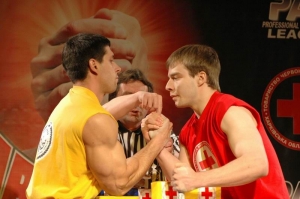 FIRST STEPS
FIRST STEPS
When I came to Alex Mundzhishvili’s section, I had a pretty good physical preparation - about ten years of training different sections of martial arts and two years experience from the school gym. Then (and I was 15) without any problems I pressed 100 kg, I was able to pull up 20 times and I did 40 push-ups on my fingers. Those who came to us from scratch had much more difficulties. Hundreds of pushups on fingers, pulling up in various grip, running with dumbbells and discs, climbing on a rope - not everyone were able to endure this, only individuals left.
And that is why I am convinced that at the initial stage, during preparations of an armwrestler, regardless of their age, should begin with a general physical preparation, from basic exercises. "The more muscles are engaged in athlete’s fight - the stronger will be his movements" - tells me Alex (a trainer), at the very beginning of our classes. If there are no muscle, what can you fight with?
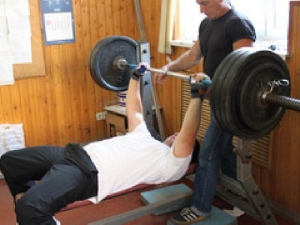 WHAT IS THE "BASE" IN ARMWRESTLING?
WHAT IS THE "BASE" IN ARMWRESTLING?
I distinguish two groups of "basic exercises". These are so-called wide-preparatory exercises and special preparatory exercises. The following characteristics for these groups of exercises are proposed by a Ukrainian athlete, coach, professor of pedagogical sciences, Anatoly Bondarchuk:
1. Wide-Preparatory Exercises (WP) "... during performance of these exercises professional movements during the entire exercise or in its part are not repeated. Here other groups of muscles are involved. With their help functions of body systems that do not guarantee an increase in sports achievements in professional training, are activated. WPs are means of the comprehensive development of individuals. They have a positive impact on raising the general level of physical efficiency and coordination. Their concomitant use with other types of exercises activates the regenerative processes."
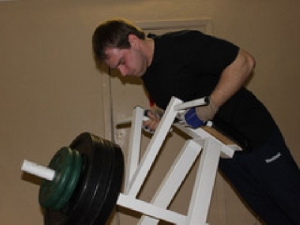 2. Special preparatory exercises (SP) "...just like the wide-preparatory ones, they do not repeat professional movements performed during the entire exercise or in its part, but similar groups of muscles participate in them. A training is accompanied by activation of these functions and body systems that affect the increase of sports results in a primary movement. The same or similar system of muscle work and different features of other systems "[Bondarchuk, AP Periodyzacja treningu sportowego 2005 p. 20].
2. Special preparatory exercises (SP) "...just like the wide-preparatory ones, they do not repeat professional movements performed during the entire exercise or in its part, but similar groups of muscles participate in them. A training is accompanied by activation of these functions and body systems that affect the increase of sports results in a primary movement. The same or similar system of muscle work and different features of other systems "[Bondarchuk, AP Periodyzacja treningu sportowego 2005 p. 20].
GROUP ONE – WE’RE BUILDING THE BODY
These are well known exercises involving multiple groups of muscles. They in a complex build muscle mass, strength of our body and hands. Every expert will tell you about the rules of carrying out such exercises: squats with a barbell , dead lift, bench press, chins on rims, various types of pull-up and stretching, bending hands with a barbell and dumbbells for biceps, bending arms at the wrists in normal and reverse grip, belly exercises - so-called "radiator".
Many people will be surprised, because what are legs for in armwrestling? On one hand, we do not need any excessive weight, especially in light and medium weight categories, but you cannot forget about legs - sooner or later “legs dystrophy" will start disturbing you in your development. Not complying with this truth, we can win in the short term, but in the long run defeat - the results can stand in place. Do not also forget about aesthetics - small legs compared to the massive shoulders look at least ridiculously. At the same time you do not have to devote too much attention to legs, you just need to strike a happy medium. It’s enough to work on this muscle group 3-4 months a year (off season).
Instead, you must pay more attention to such exercises as bench press, chins on rims, various types of pulling-up, bending and stretching because the muscles of the chest and back have a leading role in the fight at hand. I train these muscle groups myself at least once a week. When performing these exercises armwrestler should not chase records. It is important to create the necessary "corset" of muscles, which helps you in a specialist training and fight.
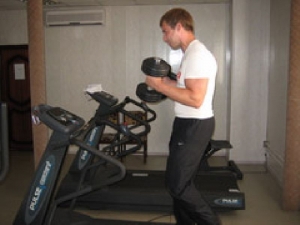 MUCH DEPENDS FROM A BICEPS
MUCH DEPENDS FROM A BICEPS
If we are talking about the work of your arms, then we slightly depart from the traditional "rocking" method. Here well-considered, alternate changes in the amplitude of the movement come out at the first plan. Both novice and experienced armwrestlers should perform alternately full and limited range of movements. Full amplitude is "basic" in the first stage for beginners and "off season" for professionals.
I do not agree with the opinion of many armwrestlers that the size of the bicep, as well as a biceps itself do not pay any significance role in armwrestling. It's hard to imagine the struggle without commitment of the muscle in one form or another.
My favorite exercise for biceps - lifting barbell while standing. This classic exercise is a part of many strength sports programs and is useful in armwrestling. I use a broken neck, work in cycles of full and limited amplitude. As to the last, I can say that it makes sense to perform this exercises at 90 degrees with a heavy load. While performing exercises in a limited amplitude I can combine the work on the dynamics and statics. I choose the weight for 10-12 repetitions, then I try to keep the barbell for another 10-15 seconds. I lift the barbell as quickly as possible, with a minimal cheating and I slowly lower it to the starting position. Between individual repetitions I do small (1-2 second) breaks. I suggest from time to time to change a grip, as it helps to improve the results.
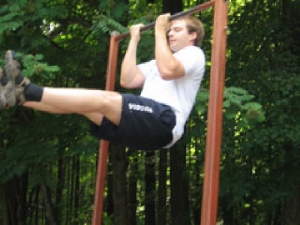 BODY, GET TO WORK!
BODY, GET TO WORK!
Now let’s consider in more detail the second group of exercises. The main task of these exercises is to strengthen ligament system in relation to specific loads in armwrestling. They are pulling-up, push-ups on fingers, running with dumbbells, climbing the rope.
In armwrestling pulling-up is very important, especially in the initial stage. You can strengthen and prepare the tendons and muscles of arm, back, shoulder to loads with which they will meet in a fight. As massive loads are waiting for them!
It is important to consider that changing a grip during pull-up, changes the load balance significantly. For example, bending arms at the final stage of the movement or keeping them bent in the whole amplitude, include muscles of the forearm in the work. It is possible to lift holding a grip with three, two, or even one finger. All of these tricks will increase strength of the grip.
While working on the bar it is also important to use interchangeably full and limited amplitude of the movement and use loads. Many outstanding athletes consider pulling a basic training. Legendary Turkish armwlestler Engin Terzi, eight-times World Champion in 4 weight categories, believes that pull-up gives him the necessary angle of the work, which he has been successfully using in the start position.
Now a few words on another very important exercise for an armwrestler - push-ups. Although push-ups are typical exercises for many sports disciplines, in armwrestling they have a specific task - strengthening the fingers and wrist. For armwlestlers the following options of the exercise are designed: push-ups on fingers, including on one hand (for wrists and fingers, it is primarily a static load on fingers), the push-ups on the outer side of the hand (wrist and forearm), push-ups on fingers with clapping in front of the chest, push-ups on fighters with clapping above the head. The last two ones are developing strength, which is crucial especially at the start. When performing this exercise, you cannot bend fingers in any case, otherwise it makes no sense to do this exercise, bending the fingers is equivalent to programming defeat in the fight.
Another exercise, which I would like to focus on is running or walking with dumbbells (or with any other load) and a climbing a rope. These exercises, strengthen ligaments and tendons, develop endurance and strengthen your working angles. At the initial stage, these exercises are extremely effective, especially for fans of "iron", who decided to try themselves in our sport. These exercises help to prepare ligaments for the next loads and will allow to pass faster to specialist exercises.
However I do not recommend to perform these exercises too frequently, because they require significant recovery time, and continue the training on them is virtually impossible. Once a week to run with dumbbells or (and) climb the rope, in the first year of serious armwrestling trainings – is more than enough.
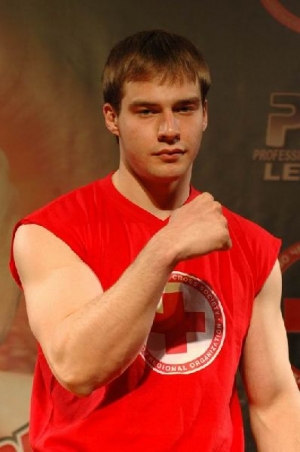 CONCLUSIONS
CONCLUSIONS
The main problem of armwrestling is unnatural movements, and a stage of pre-primary preparation and primary sports specialization are the most injury causing moments in the career of the athlete. Most of injuries occurs when the strength of muscles is many times greater than the strength of tendons and ligaments, or conversely, while the absence of a developed muscular system it does not protect joint-ligament system of the athlete. And most important moment, it is necessary to remember that the first group of basic exercises cannot exist without the second one, they are interrelated and should be treated as complex. In armwrestling you can start to decay and the stronger is your "base", the longer sports activity will be.

